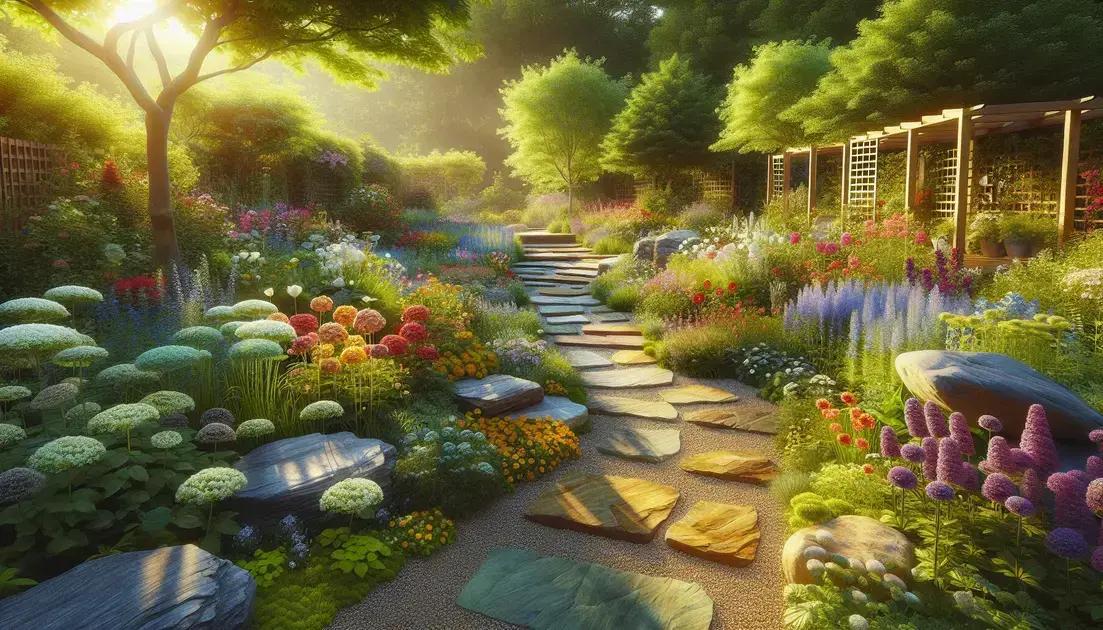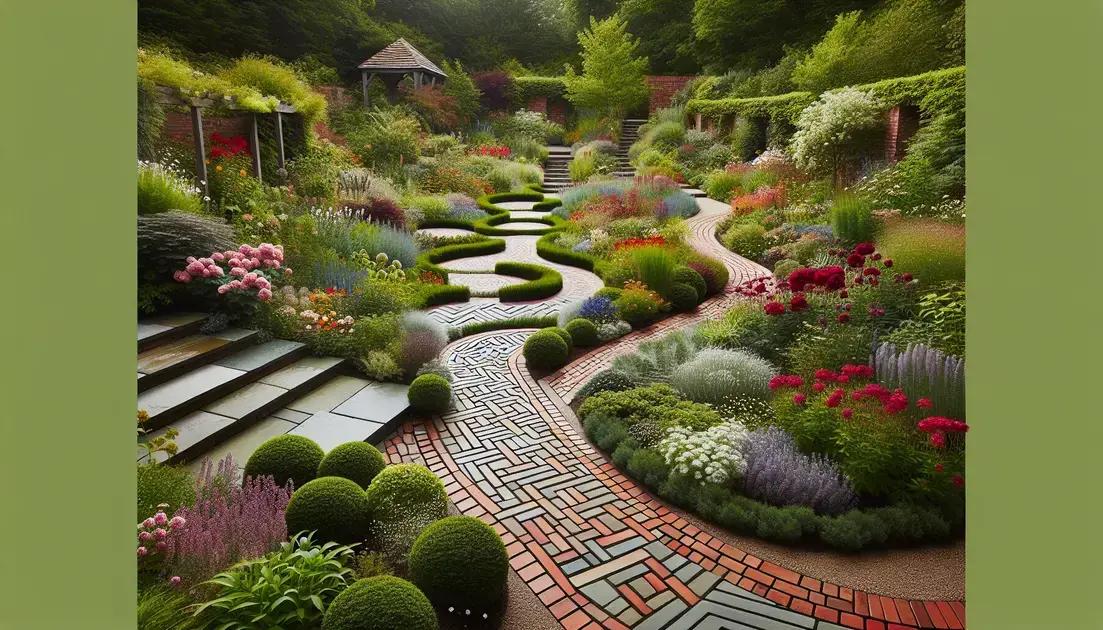Garden pathways can enhance your outdoor space with durable materials like concrete, brick, and decomposed granite, allowing for unique designs that improve aesthetics and drainage while ensuring longevity.
Garden pathways are not just practical; they add charm and personality to your outdoor spaces. Have you ever walked through a beautifully designed path and felt a sense of tranquility? Let’s explore creative ideas and tips to enhance your garden experience.
Ideas for creating beautiful garden pathways

Creating beautiful garden pathways can dramatically enhance the charm of your outdoor space. It is important to consider both aesthetics and practicality when designing these paths. Think about the flow of your garden, how people will move through the area, and what materials will complement your existing landscape.
Natural Stone Pathways
Using natural stone for your garden pathways provides a timeless and elegant look. Different sizes and shapes of stones can be arranged creatively to fit the contours of your garden. The stones can be placed directly on the ground or set in a bed of sand or gravel for added stability.
Wooden Boardwalks
A wooden boardwalk can bring a rustic charm to your garden. Using wood not only fits perfectly with a natural garden but also offers a comfortable walking surface. Make sure to choose durable woods that can withstand the elements, and consider treatments to prevent rot.
Gravel Paths
Gravel is a cost-effective and versatile option for garden pathways. It is easy to install and comes in various colors and sizes to match your garden’s theme. To keep the gravel in place, create defined edges with bricks or stones, and don’t forget to add a weed barrier underneath.
Paving Stones
Paving stones are another great option, providing a sturdy surface and a modern look. They come in numerous styles, shapes, and textures, enabling you to design unique patterns. Ensure to leave gaps between the stones for drainage and to allow ground cover plants to grow.
Plants Along the Pathways
To enhance the beauty of your garden pathways, consider planting flowers or shrubs along the edges. This not only adds color and fragrance but also creates a more immersive experience for those walking through the garden. Low-maintenance plants such as lavender, creeping thyme, or succulents can be wonderful choices.
As you plan your pathways, remember to keep accessibility in mind, ensuring that paths are wide enough for comfortable walking. Mixing materials and incorporating different shapes can help create an inviting atmosphere in your garden.
Materials and designs for durable garden pathways

Choosing the right materials and designs is crucial for creating durable garden pathways. The materials you select will affect not only the look of your paths but also their longevity and maintenance needs.
Concrete Pathways
Concrete is a popular choice for garden pathways due to its durability and versatility. It can be poured into various shapes and stamped to mimic other materials like stone or brick. Properly sealed concrete can withstand extreme weather conditions and requires minimal upkeep.
Brick Pathways
Using brick for garden paths adds a classic charm. Bricks are strong and can be arranged in various patterns to create unique designs. They can also allow for drainage, preventing water accumulation. However, bricks may need joint maintenance to keep them looking their best.
Decomposed Granite
Decomposed granite provides a natural look that works well in many garden environments. It’s easy to install and creates a compact, porous surface that is great for drainage. Plus, it comes in a variety of colors, allowing you to select one that complements your garden.
Permeable Pavers
Permeable pavers are eco-friendly options that allow water to pass through, reducing runoff and promoting healthy soil. These are available in various materials, including concrete and stone. They can be arranged creatively to combine functionality and aesthetic appeal.
Maintaining Your Pathways
Regardless of the material chosen, maintenance is key to ensuring your garden pathways remain in good condition. Regularly check for weeds, cracks, or any shifting in the pathways. Cleaning debris and applying sealants when necessary will help prolong the lifespan of your paths.
By selecting high-quality materials and thoughtful designs, you can create pathways that not only enhance the beauty of your garden but also endure for many years.
Creating Your Ideal Garden Pathways
In conclusion, designing beautiful and durable garden pathways can transform your outdoor space. By selecting the right materials like concrete, brick, or decomposed granite, you can ensure your paths not only look great but also stand the test of time.
Pay attention to maintenance to keep your pathways looking fresh and inviting. Whether you choose a classic look or a modern design, think about how your pathways will enhance the overall feel of your garden.
Your garden pathways are more than just a way to connect areas; they are an opportunity to express your style and make your garden enjoyable for all who visit.
FAQ – Frequently Asked Questions about Garden Pathways
What materials are best for creating durable garden pathways?
Durable materials include concrete, brick, decomposed granite, and permeable pavers. Each offers unique benefits and aesthetics.
How do I maintain my garden pathways?
Regularly check for weeds and cracks, clean debris, and apply sealants when necessary to keep your pathways in good condition.
Can I create a pathway with low-maintenance plants alongside?
Yes, low-maintenance plants like lavender and creeping thyme can be planted along pathways to enhance aesthetics and require minimal care.
What design styles can I use for garden pathways?
You can use natural stone, wooden boardwalks, gravel, or patterned paving stones to create various styles that fit your garden theme.
How wide should my garden pathways be?
Pathways should be wide enough for comfortable walking, generally about 2 to 3 feet wide for single use and wider for two people to pass.
Are garden pathways useful for improving drainage?
Yes, certain materials like permeable pavers and decomposed granite allow water to drain through, helping to manage runoff in your garden.
